
Thumb joint pain and inflammation can be the result of an injury or sprain to the thumb, or even some chronic disease like osteoarthritis. It is often accompanied by stiffness of the joint, and makes even simple activities like gripping or holding an object quite painful.
Ru(o)le of the Thumb!
A pithy ‘OMG’ or ‘LOL’ may well be the lingo of the youth, where sending a dozen text messages is no less than a norm, one is bound to have no mercy over that little thumb that does all the talking for you. Now a popular malady, you may develop a ‘BlackBerry thumb’, after punching the smartphone’s tiny keys. This app-lication may leave you with severe joint pain and a sore thumb! In the name of stating ‘what’s on their mind’, they end up sending over 100 text messages every day. Studies are a testimony to the fact that children spend 7 to 8 hours on an average entertaining themselves through a myriad of applications! We hope the message is delivered successfully!
Thumb joint pain can be quite intense at times, which can put restrictions on its movement and cause a lot of discomfort. The pain can sometimes radiate down the wrist, causing pain in the forearm too. Thumb pain can be accompanied by symptoms like swelling and stiffness. It can be caused by several factors, ranging from a minor injury or trauma, and even thumb arthritis.
Reasons for Your Thumb to Ache and Swell Up
Many a time, this condition, along with swelling, can be a result of a minor injury like a strain or sprain of the joint. The pain often affects the wrist, besides restricting the movement of the thumb. Such pain and swelling can be due to a sprain of the ulnar collateral ligament (ULC). This condition is termed as skier’s thumb or gamekeeper’s thumb. Besides, excessive stress on the thumb or its overuse can also lead to this condition. This is more commonly observed in the younger generation, as they tend to overuse their thumb for activities like texting. If the pain is not due to an injury, then it can be an indicator of other medical conditions, some of which are mentioned below.
Arthritis or Osteoarthritis
These two conditions are known to cause loss of cartilage in the joint. Thumb arthritis is the condition characterized by pain at the base of the thumb, whenever it is used for gripping. Along with pain, swelling and stiffness are other symptoms of this condition.
Rheumatoid Arthritis
This is another serious health condition that can lead to swelling and pain in several joints of the body. It is an autoimmune disease, where the body’s own immune system attacks the components of the joint, especially the synovial membrane. This membrane lines the joints and secretes a lubricating fluid known as synovial fluid. The result of the immune attack on this membrane is what causes pain and swelling of the joint. Apart from this, it can also lead to joint deformities.
Bursitis
Bursa is a fluid-filled sac found between the bones and the muscles or tendons around it. Inflammation of this sac is referred to as bursitis. It serves a very important purpose by acting as a cushion between the bones and muscles/tendons in order to reduce the friction between the joints, so that they can move freely. An injury to the bursa can result in significant pain of the thumb joint.
Tendinitis
Tendinitis of the thumb can be one of the most common reasons behind thumb pain. Inflammation of the tendon and its sheath, which is located along the thumb side of the wrist, can produce pain and swelling near the base of the thumb. This condition is known as De Quervain’s tenosynovitis (pronounced as: dih-kwer-VAINS ten-oh-sine-oh-VIE-tis), which causes a lot of difficulties and pain while moving the thumb and the wrist.
Treatment Options
The treatment would primarily depend on the underlying causes as well as the severity of the pain and discomfort experienced. For a minor physical injury, the pain may disappear simply with enough rest. Therefore, try to avoid those activities that can put stress on your thumb. Wearing a splint can help a lot in this regard. It would provide support and keep your thumb in a resting position, so as to ensure speedy recovery. Application of a hot and cold pack is also very effective in reducing inflammation and pain of the thumb joint.
If the pain is very severe, it is better to consult a physician at the earliest. It would help determine the root cause of the pain, which in turn will help ascertain the treatment options required for alleviating the condition. To provide temporary relief from the excruciating pain, physicians may suggest painkillers or anti-inflammatory medications. However, rheumatoid arthritis can require immune suppressant medications and analgesics along with non-steroidal anti-inflammatory drugs (NSAIDs). Exercises or physical therapy, on the other hand, can prove very effective to manage the conditions that can lead to joint pain in the thumb.
If the above-mentioned treatment options fail to relieve the pain and swelling, then surgery may become inevitable. Surgery usually involves repairing the joint or fusion of the bones. Sometimes, a portion of the bone or joint is removed and then replaced with tendon graft, which is usually performed in case of arthritis. Therefore, the surgical methods employed can differ significantly, depending on the severity of the condition.
A Few Exercises to Ease the Pain
☛ By keeping your thumb straight, try giving slow circular motions to it.
☛ Stretch your thumb away from the palm and try to touch each fingertip.
☛ Shut your fist and slowly open your hand, stretch your fingers out and then slowly close it into a fist again.
Do these above-mentioned exercises five to ten times a day. However, stop if you feel additional pain in the joints, when you are done. It is recommended that you perform these drills by dipping your hand under warm water as it has proven to be more helpful.
To sum up, this condition can indicate several medical conditions, out of which arthritis, rheumatoid arthritis, and bursitis can be termed as the most important ones. Early detection of these conditions can play a major role in preventing future complications associated with them. Therefore, if your pain does not resolve with sufficient rest and application of home remedies like an ice or hot pack, then consult your physician. Besides, discuss with him about the possibility of using physical therapy or exercises to manage the condition in the future.
Disclaimer: This article is for informative purposes only, and should not be used as a replacement for professional medical advice.





